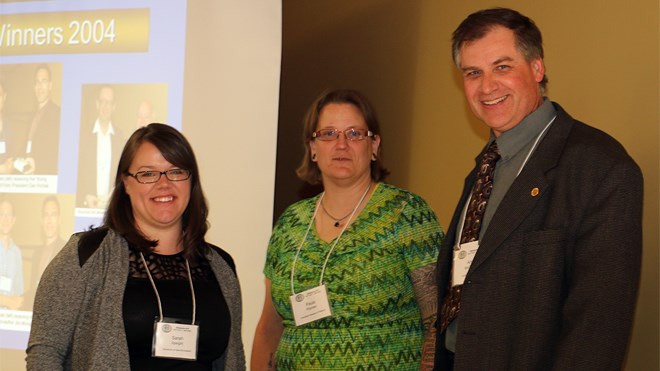A Laurentian University professor and a master's student who worked alongside him have won an award from the Mineralogical Association of Canada for a paper published in the journal “The Canadian Mineralogist.”
Andy McDonald and Sarah Gordon picked up the Hawley Medal at the joint annual Geological Association of Canada-Mineralogical Association of Canada meeting in Whitehorse, Yukon in early June.
The Hawley Medal is awarded to the authors of the best paper to appear in the “The Canadian Mineralogist” in a given year.
The award is named in honour of the late J.E. Hawley, who was distinguished professor of mineralogy at Queen's University, and wrote about the geology of the Sudbury area.
McDonald and Gordon won the award for their paper, “A study of the composition, distribution, and genesis of pyrrhotite in the Copper Cliff Offset, Sudbury, Ontario.”
“It's a nice accolade to have received, because it comes from your peers,” said McDonald, a professor of mineralogy and crystallography, and the president of the Mineralogical Association of Canada.
“It doesn't happen every day. To me, it's the science that's so exciting, and the fact that people recognize that, you know what, the science in this study is pretty good, that's to me the best part of it.”
As for Gordon, she's been trying to get into a PhD program at the University of New Brunswick, as her husband is based out of Fredericton.
“I think now it's actually helped her to get into a PhD program,” McDonald said. “Certainly it was something that gave her a leg up in getting accepted into the university.”
Vale commissioned the study the paper is based upon.
Gordon worked on the project with McDonald for more than two years, taking rock samples from the Copper Cliff Offset, which is positioned to be one of the main mines in the Sudbury area in the future.
Pyrrhotite is an abundant mineral in Sudbury, but because it only contains a tiny amount of nickel, it ends up in the tailings.
The scientists were asked to study the two different “flavours” of pyrrhotite — the way the mineral is formed at an atomic level can vary.
There was an assumption that mineral's two flavours were formed at different temperatures and under different conditions, but McDonald and Gordon found out that's actually not the case.
They also learned there's no difference in the nickel content between the two flavours.
“That's really, really important, because that's one of the main elements that they're mining for,” said McDonald.
“If they're not sure of how the nickel is being distributed, then when they're processing the ores, they get funny results because of that.”
Geology is a relatively young science, only a couple of hundred years old, he said.
“We've actually started to understand how our world works,” McDonald said. “That's kind of exciting. What it means is we often make assumptions because have such a limited amount of data, and that's what happened in this particular case.”
